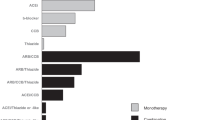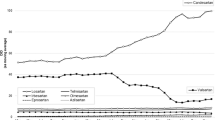Abstract
Previous studies have shown that transient treatment of animal models of hypertension with an angiotensin receptor blocker (ARB) causes a sustained decrease in blood pressure values that persists even after the drug treatment is discontinued (J Am Soc Nephrol 12: 659–666, 2001; Nephron 91: 710–718, 2002; Hypertens Res 30: 63–75, 2007). These results have been shown to be clinically relevant by the recent TROPHY study (N Engl J Med 354: 1685–1697, 2006). We have recently found that transient treatment with an ARB may also cause regression of established hypertension in hypertensive rats (J Am Soc Nephrol 18: 157A, 2007). The Short Treatment with the Angiotensin Receptor Blocker Candesartan Surveyed by Telemedicine (STAR CAST) study is a prospective, randomized, open, blinded end-point study in patients aged 30–59 with a positive family history of hypertension that will be conducted in several centers in Japan. The aim of the study is to evaluate the antihypertensive drug withdrawal success rate, the median duration of drug withdrawal, and the changes in home and office blood pressure values in patients with mild hypertension after tapering and withdrawal of antihypertensive treatment following treatment for 1 year with the ARB candesartan or the calcium channel blocker (CCB) nifedipine slow-release. A unique feature of this study is the use of a home blood pressure monitoring telemedicine system (i-TECHO) to allow frequent evaluation of the changes in blood pressure in the trial patients. This study will be the first clinical study to examine if regression from stage 1 (mild) hypertension to prehypertension (high-normal blood pressure) is possible using an ARB or CCB.
Similar content being viewed by others
Article PDF
References
Kearney PM, Whelton M, Reynolds K, Muntner P, Whelton PK, He J : Global burden of hypertension: analysis of worldwide data. Lancet 2005; 365: 217–223.
Alderman M, Ogihara T : Global challenge for overcoming high blood pressure: Fukuoka statement, 19 October 2006. J Hypertens 2007; 25: 727.
Japanese Society of Hypertension: Japanese Society of Hypertension Guidelines for the Management of Hypertension (JSH 2004). Hypertens Res 2006; 29 ( Suppl): S1–S105.
Chobanian AV, Bakris GL, Black HR, et al: The Seventh Report of the Joint National Committee on Prevention, Detection, Evaluation, and Treatment of High Blood Pressure: the JNC 7 report. JAMA 2003; 289: 2560–2572.
Cifkova R, Erdine S, Fagard R, et al: Practice guidelines for primary care physicians: 2003 ESH/ESC hypertension guidelines. J Hypertens 2003; 21: 1779–1786.
Whitworth JA : 2003 World Health Organization (WHO)/International Society of Hypertension (ISH) statement on management of hypertension. J Hypertens 2003; 21: 1983–1992.
Harrap SB, Van der Merwe MW, Griffin SA, Macpherson F, Lever AF : Brief angiotensin converting enzyme inhibitor treatment in young spontaneously hypertensive rats reduces blood pressure long-term. Hypertension 1990; 16: 603–614.
Wu JN, Berecek KH : Prevention of genetic hypertension by early treatment of spontaneously hypertensive rats with the angiotensin converting enzyme inhibitor captopril. Hypertension 1993; 22: 139–146.
Morton JJ, Beattie EC, MacPherson F : Angiotensin II receptor antagonist losartan has persistent effects on blood pressure in the young spontaneously hypertensive rat: lack of relation to vascular structure. J Vasc Res 1992; 29: 264–269.
Nakaya H, Sasamura H, Hayashi M, Saruta T : Temporary treatment of prepubescent rats with angiotensin inhibitors suppresses the development of hypertensive nephrosclerosis. J Am Soc Nephrol 2001; 12: 659–666.
Nakaya H, Sasamura H, Mifune M, et al: Prepubertal treatment with angiotensin receptor blocker causes partial attenuation of hypertension and renal damage in adult Dahl saltsensitive rats. Nephron 2002; 91: 710–718.
Ishiguro K, Sasamura H, Sakamaki Y, Itoh H, Saruta T : Developmental activity of the renin-angiotensin system during the “critical period” modulates later L-NAME–induced hypertension and renal injury. Hypertens Res 2007; 30: 63–75.
Julius S, Nesbitt SD, Egan BM, et al: Feasibility of treating prehypertension with an angiotensin-receptor blocker. N Engl J Med 2006; 354: 1685–1697.
Ishiguro K, Sasamura H, Sakamaki Y, Hayashi K, Saruta T, Itoh H : Use of transient ‘pulse’ therapy with antihypertensive agents to induce regression of established hypertension in spotaneously hypertensive rats. J Am Soc Nephrol 2007; 18: 157A.
Sakamaki Y, Sasamura H, Ikeda S, Ikegami N, Saruta T : Comparison of health costs associated with treatment of hypertension with a calcium channel blocker and angiotensin-converting enzyme inhibitor in the United States and Japan. Hypertens Res 2006; 29: 333–338.
Ryuzaki M, Nakamoto H, Nishida E, et al: Crossover study of amlodipine versus nifedipine CR with home blood pressure monitoring via cellular phone: internet-mediated openlabel crossover trial of calcium channel blockers for hypertension (i-TECHO trial). J Hypertens 2007; 25: 2352–2358.
Course of blood pressure in mild hypertensives after withdrawal of long term antihypertensive treatment. Medical Research Council Working Party on Mild Hypertension. Br Med J (Clin Res Ed) 1986; 293: 988–992.
Langford HG, Blaufox MD, Oberman A, et al: Dietary therapy slows the return of hypertension after stopping prolonged medication. JAMA 1985; 253: 657–664.
Maland LJ, Lutz LJ, Castle CH : Effects of withdrawing diuretic therapy on blood pressure in mild hypertension. Hypertension 1983; 5: 539–544.
Return of elevated blood pressure after withdrawal of antihypertensive drugs. Circulation 1975; 51: 1107–1113.
Skov K, Eiskjaer H, Hansen HE, Madsen JK, Kvist S, Mulvany MJ : Treatment of young subjects at high familial risk of future hypertension with an angiotensin-receptor blocker. Hypertension 2007; 50: 89–95.
Author information
Authors and Affiliations
Consortia
Corresponding author
Rights and permissions
About this article
Cite this article
Sasamura, H., Nakaya, H., Julius, S. et al. The Short Treatment with the Angiotensin Receptor Blocker Candesartan Surveyed by Telemedicine (STAR CAST) Study: Rationale and Study Design. Hypertens Res 31, 1843–1849 (2008). https://doi.org/10.1291/hypres.31.1843
Received:
Accepted:
Issue date:
DOI: https://doi.org/10.1291/hypres.31.1843
Keywords
This article is cited by
-
Withdrawal of antihypertensive medication in young to middle-aged adults: a prospective, single-group, intervention study
Clinical Hypertension (2023)
-
Regression of glomerulosclerosis in response to transient treatment with angiotensin II blockers is attenuated by blockade of matrix metalloproteinase-2
Kidney International (2010)
-
Prevention and regression of hypertension: role of renal microvascular protection
Hypertension Research (2009)



